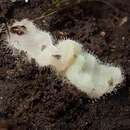en
names in breadcrumbs


Entomophthoromycota is a division of kingdom fungi. In 2007, it was placed at the taxonomic rank of subphylum in the most recent revision of the entire fungus kingdom.[1] In 2012, it was raised to the rank of phylum as "Entomophthoromycota" in a scientific paper by Richard A. Humber 2012.[2] Divided into three classes and six families (Ancylistaceae, Basidiobolaceae, Completoriaceae, Entomophthoraceae, Meristacraceae, and Neozygitaceae), it contains over 250 species that are mostly arthropod pathogens or soil- and litter-borne saprobes.[3]
Circumscribed by mycologist Richard Humber in 2012, it contains species formerly classified in the division Zygomycota. Humber's reorganization divides the division into three classes while retaining the previously defined family structure:[2]
Division Entomophthoromycota Humber 2012 [Entomophthoromycotina Humber 2007]
Genera that have an uncertain status or have been excluded from the Entomophthoromycota include Ballocephala, Tarichium, and Zygnemomyces.[3]
Synonyms from "Part 1- Virae, Prokarya, Protists, Fungi".[4] Ballocephala and Zygnemomyces were transferred to Mucoromycota division.
Species in the Entomophthoromycota generally share several characteristics. Their vegetative cells are coenocytic; sporulation occurs by production of forcibly discharged dispersive or infective conidia; and their zygospores (which also function as resting spores) are homothallic.[3]
Entomophthoromycota is a division of kingdom fungi. In 2007, it was placed at the taxonomic rank of subphylum in the most recent revision of the entire fungus kingdom. In 2012, it was raised to the rank of phylum as "Entomophthoromycota" in a scientific paper by Richard A. Humber 2012. Divided into three classes and six families (Ancylistaceae, Basidiobolaceae, Completoriaceae, Entomophthoraceae, Meristacraceae, and Neozygitaceae), it contains over 250 species that are mostly arthropod pathogens or soil- and litter-borne saprobes.
Los hongos entomoftoromicetos son parásitos de insectos y ácaros. Con menor frecuencia pueden infectar a vertebrados como el ser humano, lo que se denomina cigomicosis.
Tradicionalmente se clasifican como una subdivisión dentro la parafilética división Zygomycota, pero las clasificaciones filogenéticas le clasifican en la división Zoopagomycota la cual es monofilética.[2]
Los hongos entomoftoromicetos son parásitos de insectos y ácaros. Con menor frecuencia pueden infectar a vertebrados como el ser humano, lo que se denomina cigomicosis.
Tradicionalmente se clasifican como una subdivisión dentro la parafilética división Zygomycota, pero las clasificaciones filogenéticas le clasifican en la división Zoopagomycota la cual es monofilética.
Les Entomophthoromycotina sont une sous-division de champignons qui sont principalement des pathogènes d'insectes.
Les Entomophthoromycotina sont une sous-division de champignons qui sont principalement des pathogènes d'insectes.
Entomophthoromycotina é um subfilo de fungos que inclui uma única ordem, a Entomophthorales.[1][2] Pertencia ao grupo Zygomycota, mas esse agrupamento foi considerado polifilético baseado em análises filogenéticas.[3]
Entomophthoromycotina é um subfilo de fungos que inclui uma única ordem, a Entomophthorales. Pertencia ao grupo Zygomycota, mas esse agrupamento foi considerado polifilético baseado em análises filogenéticas.
곤충곰팡이류는 곤충곰팡이문에 속하는 균류의 총칭이다.[1][2] 3개의 하위 강으로 분류하고 있다.
다음은 2018년 테더수 등(Tedersoo et al. 2018)의 진균류 계통 분류이다.[3]
진균류 호상균아계블라스토클라디아균아계 / 블라스토클라디아균문
바시디오볼루스균아계 / 바시디오볼루스균문
올피디움균아계 / 올피디움균문
포충균아계 쌍핵균아계